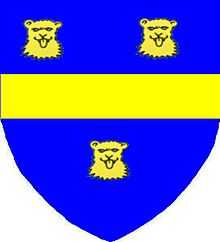Michael de la Pole, 1st Earl of Suffolk
| Michael de la Pole | |
|---|---|
| Born | c. 1330 |
| Died |
September 5, 1389 France |
| Occupation | Lord Chancellor |
| Spouse(s) | Catherine Wingfield |
| Children | Michael de la Pole |
| Parent(s) | William de la Pole & Catherine Norwich |
Michael de la Pole, 1st Baron de la Pole, later 1st Earl of Suffolk (c. 1330 – September 5, 1389) was an English financier and Lord Chancellor of England.
Life
He was the oldest son of Sir William de la Pole (d. 1366) and Catherine Norwich, daughter of Sir Walter Norwich. His younger brother was Edmund de la Pole (Captain of Calais).
His father was a wool merchant from Hull who became a key figure during the reign of Edward III: after the collapse of the Bardi and Peruzzi families, he emerged as Edward's chief financier. Michael enjoyed even greater popularity at court than his father, becoming one of the most trusted and intimate friends of Edward's successor, Richard II.
He was appointed Chancellor in 1383,[1] and created Earl of Suffolk in 1385, the first of his family to hold any such title. However, in the late 1380s his fortunes radically altered, in step with those of the king. During the Wonderful Parliament of 1386 he was impeached on charges of embezzlement and negligence, a victim of increasing tensions between Parliament and Richard.[1][2]

Even after this disgrace, he remained in royal favour, although soon fell foul of the Lords Appellant. He was one of a number of Richard's associates accused of treason by the Appellants in November 1387. After the Appellants' victory at Radcot Bridge (December 1387) and before the so-called Merciless Parliament met in February 1388, De La Pole shrewdly fled to Paris, thus escaping the fate of Sir Nicholas Brembre and Chief Justice Robert Tresilian. He remained in France for the remainder of his life. Sentenced in his absence, his title was stripped from him.
Jean Froissart's references to de la Pole in the Chroniques (II.173) portray a devious and ineffectual counsellor, who dissuaded Richard from pursuing a certain victory against French and Scottish forces in Cumberland, and fomented undue suspicion of John of Gaunt, 1st Duke of Lancaster.[3]
De la Pole's descendants by Catherine Wingfield were key players in the political life of the next two centuries at Wingfield Castle in Suffolk:
- His son Michael de la Pole, 2nd Earl of Suffolk was a supporter of Henry IV and opponent of Richard. He regained his father's title on Henry's accession in 1399, and died at the Siege of Harfleur.
- His eldest grandson Michael de la Pole, 3rd Earl of Suffolk died at the Battle of Agincourt.
- His younger grandson William de la Pole, 1st Duke of Suffolk was appointed Lord Chamberlain under Henry VI, before being murdered in exile.
- His great-great grandson was Edmund de la Pole, 3rd Duke of Suffolk, who led a failed rebellion against Henry VII in 1501.
He was also, via his daughter Anne de la Pole, the great-grandfather of Richard West, 7th Baron De La Warr.
Notes
- ↑ 1.0 1.1 Powicke, F. Maurice and E. B. Fryde Handbook of British Chronology 2nd ed. London: Royal Historical Society 1961 p. 85
- ↑ J.S. Roskell, The Impeachment of Michael de la Pole, Earl of Suffolk in 1386 in the Context of the Reign of Richard II (Manchester: Manchester University Press, 1984) ISBN 0-7190-0963-4
- ↑ Jean Froissart, Memoirs of the Life of Froissart: with an essay on his works ; and a criticism on his history, trans. by Thomas Johnes (London: Nichols and Son, 1801)
See also
External links
| Political offices | ||
|---|---|---|
| Preceded by Robert Braybrooke |
Lord Chancellor 1383–1386 |
Succeeded by Thomas Arundel |
| Peerage of England | ||
| New creation | Earl of Suffolk 1385–1388 |
Succeeded by Michael de la Pole |
| Baron de la Pole 1366–1388 | ||
|